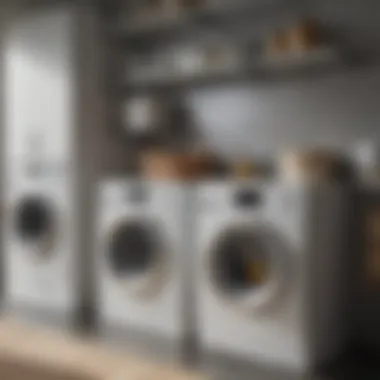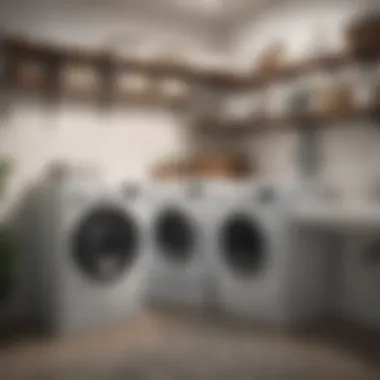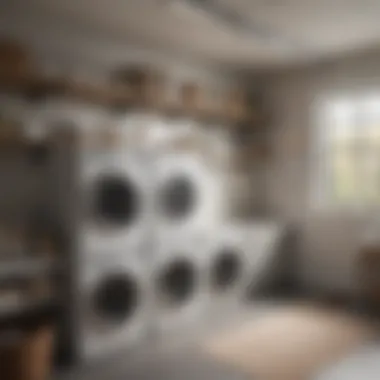Maximize Laundry Room Space with Smart Shelf Designs


Intro
Creating a functional and visually appealing laundry room is a challenge for many homeowners. One common problem is the limited space available above washer and dryer units. Simply placing baskets and supplies directly on the units can lead to clutter, reducing the efficiency of this area.
This article delves into the practical aspects of optimizing laundry room space by designing shelves that can be installed above washer and dryer setups. Using this guide, house owners will discover the right materials, tools, and techniques to ensure a seamless installation that meets both functional and aesthetic needs.
Materials:
To begin your shelf project, gather the necessary materials as listed below:
- Plywood or MDF board: Three 3/4" thick boards, each 6 linear feet long.
- L-brackets: Six heavy-duty brackets (3 for each shelf).
- Wood screws: 2" screws, 24 counts.
- Wall anchors: 12 counts, rated to support at least 50 lbs.
- Sandpaper: 220-grit for smoothing edges.
- Paint or wood stain: Optional, choose based on your decor.
- Sealer: To protect against moisture, particularly if using in humid laundry areas.
DIY Steps:
Follow these detailed instructions to create your shelves:
Step 1: Measure the Space
Use a tape measure to assess the area above your washer and dryer. Note any pipes, windows, or ventilation required. This measurement will guide the size and number of shelves needed.
Step 2: Cut the Boards
Using a circular saw, cut your plywood or MDF board to the specified lengths above. Standard widths are usually 12–16" so choose whichever fits best.
Step 3: Sand the Edges
Smooth the edges of the cut boards with 220-grit sandpaper. This important step will help prevent injuries from sharp edges.
Step 4: Prepare the Installation Area
Clean the wall area where the shelves will be placed. If usable, paint or stain your shelves, letting them dry completely.
Step 5: Attach Wall Brackets
Join L-brackets to the wall at desired spacing, ensuring they are level using a spirit level. Use wall anchors to secure brackets into the drywall or studs.
Step 6: Install Shelves
Position the shelves atop the installed brackets. Secure the shelf to the brackets using wood screws for added durability.
Technical Aspects:
Tools Required:
- Drill
- Circular saw
- Tape measure
- Spirit level
- Screwdriver
- Sandpaper
Time Investment:
This entire project should take roughly 4-6 hours from start to finish. This includes preparation, installation, and cleanup.
Key Techniques:
- Always double-check your measurements before cutting wood.
- Use a level frequently while mounting brackets to ensure shelves remain straight.
DIY project Process:
Installation Method:
Install one shelving unit at a time. To begin and keep things organized, focus on securing the brackets first. Then place the shelves one after another tipping safely to avoid unnecessary haste.
Troubleshooting Tips:
- If your shelf is unsteady, ensure screws are tightly secured into the brackets.
- Inspect wall materials; drywall may necessitate installing additional wall anchors.
- Use shims if shelves are not level, adjusting them to find balance.
Remember, well-placed shelving can not only declutter your laundry room, it also can enhance the overall function of the space.
Further tips can often be discovered by exploring discussions add online platforms such as Reddit or dialing into community-based resources on Facebook. Getting advice from others can offer fresh perspectives.
With these steps, you are one blueprint away from an efficient and visually striking laundry space.


Intro to Laundry Room Shelving
The manner in which a laundry room is organized can significantly influence both the efficiency and ease of performing laundry tasks. Effective shelving solutions over washer and dryer units are vital, especially in environments often characterized by limited spaces. The benefits of appropriate shelving not only enhance organization but also increase functionality. This article will explore every essential component related to this matter, ensuring that readers can understand the importance of thoughtful design.
Importance of Vertical Space Utilization
Vertical space utilization is a crucial aspect of laundry room design. Many homeowners often overlook areas above their machines, leaving prime storage opportunities unused. By installing shelves in these locations, practical storage can be created for both cleaning products and personal items. One of the noteworthy benefits is reducing clutter on surfaces, allowing for a more organized environment.
Moreover, incorporating vertical storage allows for more efficient. Users can access their items without searching through bins on the floor. Items can be arranged continually with easy visibility, which can save substantial time. This essentially transforms a potentially chaotic area into a streamlined workflow. Proper design choices related to shelving can ultimately make laundry more than a tedious chore, benefitting individuals and families.
Challenges of Limited Laundry Room Space
Many laundry rooms are confined in terms of space. This can lead to several challenges, particularly when trying to organize cleansers, fabric softeners, and essential tools. The small area may leave little room for conventional purchases such as closet-style shelving.
As disorganization becomes inevitable, many items can be left unattended on counters or floors leading to further stress. Items left idle can take away from the aesthetic appeal of the space, making it less welcoming. Additionally, the trend is toward smaller home designs that impose restrictions on square footage, making shelving installation essential. Even well-placed shelves may burden materials that must be easily accessible but well-organized, elevating the complexity of the arrangement. Simplifying this aspect without sacrificing effective utilization of the space remains a challenge.
By examining the ramifications of limited laundry room spaces, the importance of customized or niche shelving solutions become apparent. These fulfill storage needs while considering comfort and convenience for users. Conclusively, a nuanced approach to installing shelves over washer and dryer units can alleviate common obstacles linked with limited laundry room configurations.
Types of Shelves for Washer and Dryer Areas
The inclusion of shelves in a laundry room is crucial for maximizing space and promoting organization. Efficient shelving provides additional storage that can drastically reduce clutter. Understanding the types of shelves suitable for washer and dryer areas can aid homeowners in their decisions, making the best utilization of available vertical space. Each type of shelf has unique benefits and constraints that should be considered before installation.
Wall-Mounted Shelves
Wall-mounted shelves serve as an excellent choice for consolidating hardly-used items above washer and dryer units. This option effectively utilizes vertical space and can be customized to fit various sizes, styles, and needs. When installing wall-mounted shelves, factors like the distance between the shelf and the appliances are essential. Here, the goal is secure and reachable placement, avoiding any inconvenience while operating the machines.
Benefits of Wall-Mounted Shelves:
- Maximizes Vertical Space: They allow clear floor area.
- Customization: Available in different materials and designs.
- Ease of Access: Provides convenience for feeding detergents or organizing clothespins.
However, consider potential weight limits depending on the materials used. Regular inspection is key to making sure they remain stable and secure.
Freestanding Shelving Units
Freestanding shelving units offer a flexible solution for organizing laundry supplies and other essentials within the laundry area. These units can stand anywhere in the room, providing versatility beyond fixed shelving. The adaptability also allows homeowners to rearrange them as necessary.
Important Considerations:
- Space Adjustment: Can be moved around based on available area
- Available Size Options: Varies from small units to larger cabinet-style designs.
- Easy Accessibility: They typically require less effort to access items stored than on high shelves.
Notably, when choosing freestanding options, ensure they are stable to prevent any unit tipping or falling occurrences. Perhaps securing them against walls could be a wise precaution.
Customized Shelving Solutions
For those looking to perfectly tailor their laundry room appearance and function, customized shelving solutions represent an optimal bond between aesthetics and utility. Different configurations can help encapsulate elements desired for individual needs, housing various items while maintaining a coherent layout.
Customization allows the incorporation of features such as:
- Embedded hampers
- Integrated drying areas
- Specialized divisions for jars, bottles, and tools
While these options might require more investment, the pay-off illustrates effective organization, especially in complex or small areas. This approach aligns aesthetics with functionality, bringing a unique touch to the laundry room.
Through appropriate evaluation of these shelving types, individuals can achieve a customized storage area that increases both efficiency and accessibility in their laundry rooms.
Key Considerations for Shelf Installation
Installing shelves over washer and dryer units requires careful planning. A few specific aspects ensure not only proper usability but also safety and durability. By addressing these key factors, homeowners can optimize their laundry rooms and make the process more effective.
Safety and Stability Factors
Safety is paramount when designing any shelf system. The shelves must securely attach to the wall, especially considering vibrations from the machines. It is important to use appropriate hardware, such as anchors and screws, that can support the load while withstanding movement.
When choosing the location for shelves, away from the front of the laundary machines may help reduce risks of goods or persons falling. Because laundry rooms often become humid, materials which resist moisture can also help maintain stability. Avoid inexpensive, flimsy shelves which might not sustain shelves or items perched on them.
A well-installed shelf must not only hold items but should also endure movement and moisture encountered in a typical laundry environment.
Weight Capacity Assessment
Choosing materials isn't only about looks. A proper assessment of weight capacity is essential. Each shelf designed for overhead installation must calculate how much stress it will face under heavy loads. There are shelves designed specifically to handle substantial weight, such as a sturdy metal rack, whereas lighter wood may simply sag if overloaded.
Consider evaluating how many items or basket loads to place on each shelf regularly to ensure that you do not unintentionally overload the structure.


Appropriate Height and Reach
Overall usability can affect the height where shelves are located. Shelves should be sentimental enough for owners to reach comfortably, but also functionally spaced where tools and supplies remain accessible.
Typically, placing shelves 18 to 24 inches above the washer or dryer damping dimensions is sufficent for lowering spaces. This toy guarantee even the tallest person or even one using a stool can effectively organize items without overwhelming obstacle. Moreover, adjustable shelving could even elevate functionality.
Keeping all these justified factors in mind will go a long way towards installing shelves that are not merely aesthetic but also functional and safe. Properly accounting for considerations like safety, weight support, and accessibility leads to optimal use of laundry space.
Material Selection for Laundry Room Shelves
Choosing the right material for laundry room shelves is a crucial aspect of your overall design. The material selection impacts both the functionality and the visual appeal of your shelves. Each material has its unique traits. Understanding these differences helps in making informed decisions based on your specific needs.
Wood vs.
Metal Shelving
When deciding between wood and metal shelving, it's important to consider the benefits and drawbacks.
- Wood Shelves: These offer warmth and character. They are easier to customize and can fit various designs. However, wood may not be the best for humid environments as it can warp or rot over time.
- Metal Shelves: These provide sturdiness and durability. Metal is less likely to warp or suffer from moisture problems. Opening options include powder-coated steel. This finish not only adds durability but also comes in various colors, so you can match your laundry room's aesthetic.
Both materials serve different purpose, as their usage depends on the desired design as well as practical considerations of the space.
Durability and Moisture Resistance
Durability is paramount in any environment where moisture is present. Metals, particularly stainless steel or coated options, resist corrosion and do not support mold growth. Wood can perform well if treated adequately but lacks an inherent resistance.
Recommended Features:
- Select woods that are pressure-treated or are naturally moisture-resistant, such as cedar.
- Ensure that metals used are rust-proof. A good option is stainless steel which combines aesthetic appeal and durability.
Impacts on Longevity: Investing in proper materials avoids frequent replacements. This saves not only money but also fits into a sustainable approach. Proper selection ensures peace of mind.
Finishes and Aesthetics
An often overlooked consideration involves the finish of the shelving unit. The services a shelf provides go hand-in-hand with the overall feel of the laundry room.
- Textured Finishes: These effectively hide fingerprints and water marks. Textures also add depth to the space visually.
- Color Options: Target colors that align with your laundry room theme. Neutral hues keep the space vibrant and light. Bold colors create focal points and demonstrate personal style.
In ski matters, finishes protect the surface from damage and improve the architectural setup of the room. Think about both the functional elements and how they integrate into the room describing your personal lifestyle.
Ultimately, the right choice in materials contributes significantly to both the style and function within the often-overlooked closed spaces. Regular evaluations can assist in maintaining that balance throughout the years.
Design Ideas for Enhanced Functionality
In a typical home, the laundry room often ends up as a neglected space, primarily used for one purpose. However, thoughtful design can elevate this area. Implementation of functional design ideas enhances usability and aesthetics. Structurally sound shelves not only offer more storage but can transform the laundry experience. Here, we will examine elements contributing to enhanced functionality, including storage consolidation, and creative usage of available space.
Incorporating Baskets and Containers
Baskets and containers efficiently organize laundry essentials. When designed to complement shelves, these items improve accessibility. Include different-sized baskets to tackle various objects like detergents, fabric softeners, or miscellaneous tools. A practical tip is to use labels on baskets. This helps in quickly identifying contents. The result is a tidy appearance that makes laundry tasks less burdensome. Consider investing in stackable containers to maximize vertical space, too. Utilizing the vertical dimension can significantly enhance room organization.
Combining Shelves with Hooks
Integrating hooks to the shelves creates additional functionality. Hooks provide versatile options for storing items that do not fit into baskets, like drying towels or clothing that need airing out. Place hooks where they are easily reachable. This option not only frees up shelf space but also quickens your workflow. Another benefit includes improved air circulation, helping to reduce moisture build-up. When combined effectively, shelves with hooks can help eliminate clutter while improving utility in the laundry area.
Color Coordination and Style
Design elements also engage visually. Choose colors that reflect personal style while aligning with room themes. Neutral shades can promote a sense of calm, while brighter tones can invigorate the space. Integrating color with shelf design can make a strong impact. Consider painting or selecting containers that match or contrast with wall hues. Calibrated color choices go beyond aesthetics; they provide visual cues that can enhance organization by arranging items based on color. This logical structuring can give otherwise anonymous laundry items distinct identities.
“A cohesive design not only looks great but also promotes logical organization.”
Thoughtfully implemented design ideas will certainly improve functionality in your laundry room. The impact these elements have can sometimes surpass expectations, promoting not only aesthetic allure but the practical execution of chores.
Maintenance and Care of Laundry Room Shelves
Maintaining and caring for laundry room shelves is essential for longevity and continued performance. Over time, these shelves are subjected to weight and moisture, making routine care critical. Failure to address issues early may result in safety hazards and financial loss due to damage.
Regular inspections and proactive maintenance can prolong the life of shelving units. The right strategies ensure that the laundry room operates smoothly while providing the functional space it is meant to support.
Regular Inspection for Damage


Regular inspection of shelves keeps the laundry room safe and organized. When performing an inspection, look for signs of wear such as cracks or weakened supports. This type of thorough checking enhances longevity. Here are key elements to consider:
- Check for Warping or Bowing: A damaged shelf may sag under weight. Be aware of visible deformities, as they indicate stress.
- Examine Fasteners and Mounts: Loose screws, bolts, or brackets can compromise safety. It's crucial to tighten these components regularly.
- Inspect Connections and Joints: Look carefully at how shelves connect to the walls or other units. Any gaps indicate a need for urgency.
Performing these inspections every few months is a good practice. If any irregularities are noticed, consider addressing these issues before they worsen.
Cleaning Techniques for Different Materials
Cleaning methods vary based on the materials from which shelves are constructed. Certain materials require specific care techniques to avoid damage. Here’s a closer look at recommended practices:
- Wood Shelves: Use a soft cloth and a mixture of water and vinegar to lightly wipe the surface. Avoid soaking or scrubbing aggressively to prevent damage.
- Metal Shelves: Mild soap and warm water generally suffice for cleaning metals. Use a non-abrasive scrub to retain the finish and remove dirt effectively.
- Plastic Shelves: These are quite forgiving. Regular soap and water work well. Ensure to dry fully to avoid moisture issues in a laundry environment.
Regular wiping keeps the visibility clean and prevents dust accumulation as well. This practice helps extend the lifespan of your shelves.
Reinforcement and Repairs
Reinforcement is a vital part of shelf maintenance. If inspection reveals structural weaknesses, it’s important to repair them promptly. Several strategies can be implemented:
- Add Extra Brackets: Strengthen support by adding brackets where necessary. It’s cost-effective and reinforces overall stability.
- Replace Worn or Damaged Parts: Keeping spare parts can help you fix issues quickly. Inspect existing components regularly, so you know when to replace them.
- Use Strong Hardware: Select hardware appropriate for the weight and material of your shelves. %Using high-quality screws and brackets minimizes risk of failure.
By focusing on these repair strategies, you ensure that your laundry shelves remain safe, stable, and functional.
Remember, proper care not only extends the life of your laundry room shelves but also enhances safety and usability in your space.
Consider these aspects of maintenance and care while integrating-shelves into your laundry design. They are integral to ensuring a functional setup that meets your needs.
Accessibility and Organization Strategies
Accessibility and organization in a laundry room is crucial for creating an efficient and functional space. Many homeowners overlook the potential for well-organized storage, especially in often ignored areas like above the washer and dryer units. Effective shelving not only visually enhances room but also significantly improves day-to-day usability. Following appropriate strategies ensures all items are easily reachable and decluttered, ultimately streamlining laundry tasks.
Labeling and Categorizing Items
Labeling items can simplify the search for laundry supplies. Sticking to a defined category helps maintain order. For example, similar products can group together. You can use methods such as color-coded labels or simple text to identify products. Consider the following:
- Detergents and Softeners: Keep these together.
- Stain Removers: Separate for quick access.
- Washable Items: Labels showing which items can be washed.
Categorizing not only keeps materials tidy; it educates about where items belong. Clear icons or visuals could be beneficial. This can especially aid when children assist in chores, reducing frustration and increasing efficiency.
Maximizing Shelf Space with Stacking
Stacking is vital in utilizing every inch available on shelves. It offers an effective way to fit more items in a confined area. By choosing uniform containers, one can use vertical height to maximum advantage. Keep a few factors in mind:
- Weight Distribution: Balance heavier items at the bottom to avoid accidents.
- Uniform Container Size: Use bins or boxes that maximize how they fill the space. If all containers match size, stacking becomes easier.
- Accessibility: Regularly use items should stay on lower levels for simple reach. Less often used items can go higher.
Incorporating modular ways for stacking can allow flexibility. Some might choose dedicated laundry baskets that fit within spaces neatly.
Utilizing Clear Storage Bins
Using clear storage bins can greatly enhance both organization and visibility in a laundry space. Transparency allows anyone entering the room to located specifics swiftly. This can make laundry better organized and visually balanced. Where applicable:
- Categorization in Bins: Allocate units for specific categories, like laundry tools or extra products. Important to label bins too. Know at glance what's inside.
- Different Sizes: Invest in bins across sizes to fit different shelves' height capability. Larger bins can store bulk items while smaller bins accommodate items frequently used.
- Improvement in Efficiency: Quick visibility encourages consistent organization. By simply looking to a bin, one easily remembers where everything lies, resulting in smoother laundry sessions.
In summary, a prominent focus on accessibility and organization strategies creates harmony and reduces countertop clutter. Utilizing practical labeling, effective stacking, and transparent storage all work together. Whether you are setting up a basic laundry solution or an elaborate system, consider each approach while integrating shelves over washer and dryer units to ensure treasured space is efficient and pleasant to work in.
Epilogue: Effective Laundry Room Organization
Effective organization in the laundry room is crucial for creating a functional and harmonious space. This part of the house often serves multiple purposes and can quickly become cluttered. Therefore, organizing is not just about aesthetics; it's also about functionality. Efficiently organized systems facilitate easy access to laundry essentials and can significantly boost productivity during laundry tasks.
Emphasizing vertical storage through shelves over the washer and dryer is a key strategy. By utilizing these areas wisely, homeowners can turn wasted space into practical storage solutions. This leads to a cleaner and more orderly environment, enhancing the overall laundry experience.
Reviewing Essential Points
The primary considerations we have discussed must be kept in mind. Here are the essential takeaways:
- Vertical Space Utilization: Exploit every inch of available vertical space. Shelves above washers and dryers can host various items ranging from detergents to household supplies.
- Material Selection: Whether choosing wood, metal, or a combination, the materials should provide strength and resist moisture. This ensures durability and longevity in your laundry room.
- Safety Protocols: Safety in shelf design and installation remains paramount. Ensuring stability prevents accidents and maintains an organized space.
- Accessibility and Organization: Implement strategies such as labeling, stacking, and clear storage bins to enhance ecological organization within the space.
Future Trends in Laundry Room Design
Looking ahead, trends in laundry room design reflect broader shifts in home functionality. Minimalistic aesthetics are gaining popularity. Simplified designs combined with efficient storage options capture today’s demand for versatile spaces.
Moreover, sustainability considerations will dominate material selection. Homeowners increasingly prefer eco-friendly materials that are sustainable and contribute to creating a healthier indoor environment.
Smart Technology: The integration of smart home technology within laundry settings will rise. Devices paired with mobile apps allow for monitoring cycles and alerts, leading to optimized workflow.
Additionally, customizable shelving solutions will likely become more prevalent, enabling homeowners to adapt their spaces to fit personal needs and preferences better.
“The main goal should be to blend functionality with aesthetics while ensuring efficiency.”







